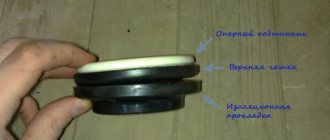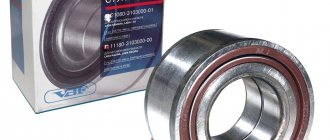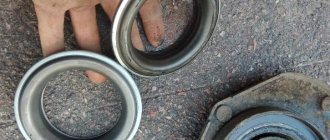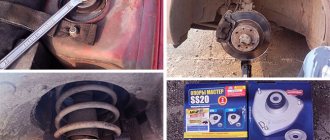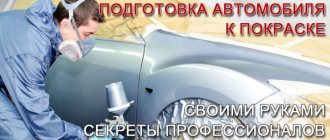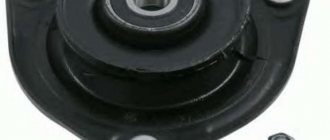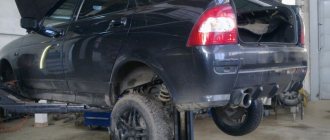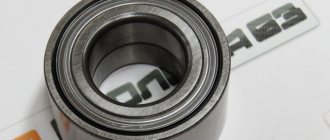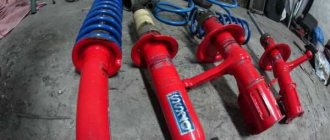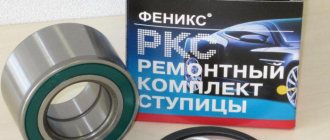The support bearing is the main element of the upper support of the front shock absorber strut, which serves for its movable connection with the body. While the car is moving, it experiences enormous shock loads, a significant part of which is taken by the “support”, absorbing and distributing them.
The support bearing itself is a rubber cage of a certain diameter with steel balls placed around its circumference. It is protected from above and below by thick rubber gaskets.
Malfunctions
The main sign of a failed support bearing is a knocking sound (dull knocks) in the area of the shock absorber strut. It may indicate that:
- the rubber gasket is damaged or deformed;
- The bearing itself is damaged.
Failure of the support bearing may occur due to:
- resource spent;
- penetration of dirt and moisture;
- exceeding permissible loads;
- mechanical damage due to shock absorber malfunctions.
How to identify a malfunction
To diagnose a support bearing failure, open the hood and remove the “cup” cover. Place your palm on the shock absorber housing and rock the front of the car. If you hear a knock and feel the corresponding vibration with your hand, the bearing is clearly faulty.
When to change
The service life of the “supports” is on average 50-100 thousand km, depending on the conditions in which the car is operated. After this resource has expired, it is recommended to change them. Replacement is also necessary if any malfunctions are detected.
Late diagnosis, as well as ignoring bearing failure, threatens to destroy the shock absorber structure and other suspension elements.
Prices for support bearings for Lada Kalina start from 300 rubles. The shock absorber support assembly costs from 1200 to 3000 rubles. When choosing a support bearing or the entire support, give preference to either the original part or such proven brands as FENOX, TRACK, ASOMI or SS-20.
For the work of replacing one bearing at a service station, you will be asked for an average of 500 rubles. You will have to pay the same amount for adjusting the wheel alignment angle (wheel alignment).
Diagnostic nuances when a knocking sound occurs when turning the steering wheel
Steering noise when turning can be caused by several reasons. To accurately determine the problem, you need to find out three factors:
- Type of noise . It can be single or repeated, voiced or voiceless (often metallic), quiet or loud.
- Place of origin of sound . For example, from a wheel, steering wheel or suspension.
- Conditions for appearance . While driving, turning the steering wheel in a parking lot, when turning the wheels all the way, when making a left or right turn.
From this information, you can determine the culprit of the knocking noise.
- Knocking in the wheel . Fragmentary destruction of the angular velocity joint, manifested as a rupture of the boot or bearing defect, noise of steering rods/tips, steering rack when driving over potholes, knocking of the shock absorber strut spring or stabilizer strut.
- Rack knocking . Defective rack shaft, too much play in bearings or bushings on the shaft. If the car is equipped with an electric steering gear, mechanical destruction of the motor shaft or worm gear, wear out of the steering shaft cardan.
- Knock in the steering wheel . Partial breakdown of the steering rack, corrosion on its drive shaft, depreciation of the worm gear or problems with the mechanical part of the electric motor.
- When turning the steering wheel to extreme positions . This happens after replacing the front control arm. When turning, it catches the subframe. If the mechanic at the service station has not tightened the fasteners properly, then creaking in these places will be inevitable.
- While turning the steering wheel in a stationary vehicle . Problems with the steering rack, driveshaft crosspiece, insufficient tightening of fasteners, rods and steering wheel ends.
- When turning the steering wheel while driving . Caused by the same reasons as when the car is stationary. It may also be due to faulty shock absorber and stabilizer struts.
Replacement
- jack;
- wheel wrench;
- open-end wrench 19;
- open-end wrench 17;
- socket wrench 13;
- pliers;
- ring wrench 22 and open-end wrench 9;
- special puller for tie rod ends;
- 2 special spring ties.
Execution order
- We park the car on a level surface and put it in gear.
- We jack up its front part on the desired side and remove the wheel.
- Using pliers, unscrew the nut securing the steering tip to the strut and unscrew it with a 19 mm wrench.
- Using a tip remover, remove the tip pin from the shock absorber strut. As a last resort, the finger can be knocked out by prying it up with a small pry bar and carefully tapping it from below.
- Using a 19mm wrench, unscrew the 2 nuts securing the strut to the steering knuckle. If necessary, hold the bolt heads with a 17 wrench.
- Using a 13 mm socket wrench, unscrew the 3 nuts securing the support to the body.
- We remove the entire shock absorber.
- We install two ties on the shock absorber spring and compress it until the upper part of the shock absorber is released.
- Using wrenches 22 and 9, unscrew the upper support nut on the upper side of the shock absorber.
- We remove the support, disassemble it, and remove the worn support bearing.
- We install a new one in its place.
- We install the shock absorber in the reverse order.
Quick Guide
The main reason for tapping is the formation of a gap in the joints. In the steering system, there may be knocking on the tips, ball joints of the rods, the rack, the “cardan” in the column, the steering wheel on the shaft, or the auto-folding system in case of an accident. The metallic sound is distinct and can be heard in place when rocking the steering wheel.
It is quite possible to mistake problems in the suspension for problems in the steering, since the initial stages of wear of bearings and supports only make themselves felt when cornering at speed. In the suspension part, the cause of the knock should be sought in the wheel bearings, ball joints and “supports”.
Purpose of the front strut support bearing
Let's take a specific technique - the VAZ-2110 car. This model has independent front suspension with hydraulic struts.
The main purpose of the strut is to dampen vibrations that occur when the spring moves.
How does this happen? For example, a wheel of your car falls into a hole. This, in turn, causes one side of the vehicle to sway. In the absence of a stand, such vibrations could continue for a long time.
Fastening is of particular importance. In the upper part the rack is fixed directly to the body, and in the lower part - to the rotary cam.
To ensure a movable connection between the body and the shock absorber, a special transition element is provided - a support bearing.
The name “support” reveals the essence of this unit and its location - at the junction with the car body.
Structurally, the device must withstand maximum radial and axial loads.
Verification methods
Checking the condition of the support bearing is not difficult, but the technology depends on the design features of the rack itself.
It is worth noting here that such a check will not give an accurate result; you can verify that the bearing is faulty only after removing it from the car.
But, nevertheless, by performing a number of simple steps you can determine the condition of the upper support.
If we take the VAZ-2110 model, then its support bearing is installed in the support itself.
To check its condition, you should ask an assistant to rock the car in the transverse direction (not too much), while at this time we place our hand on the protruding part of the pillar in the engine compartment.
If the bearing is worn out, play will be felt by hand. Also, in a damaged element, such rocking is usually accompanied by the appearance of third-party sounds - creaks, clicks.
If all this is found during the inspection, it’s time to inspect the support.
On models such as Lada Priora, Lada Kalina, or, for example, Nissan X-Trail, the bearing is not included in the support structure, so it cannot be checked by rocking it. The only sign of wear is the appearance of a knocking sound when driving.
But it is still possible to further verify that the unit is faulty.
To do this, ask an assistant to turn the steering wheel in different directions. At the same time, we put our hand to the spring.
If the bearing is heavily worn, then wedging may appear in it, which will be reflected well into the spring in the form of vibration and mild “shooting”.
Read about the reasons why you hear a knocking sound when turning the steering wheel.
Types and features of support bearings
Today, VAZ-2110 cars use several main types of bearings:
1. With built-in ring (can be internal or external). In such products, the manufacturer provides special holes for installation. Therefore, there is no need to use additional flanges.
The peculiarity of such a bearing is that it ensures rotation of any units when using different rings (internal or external).
2. With detachable ring (installed inside).
3. With detachable ring (installed externally). The peculiarity of this option is that the inner ring seems to “merge” with the body, and the outer ring can be separated if desired.
4. Single split bearing. In principle, its features are not very different from the nodes described above. The only difference is the greater rigidity of the ring.
How to check the strut support bearing yourself
Please note that it is advisable to check the support not only when it fails, but also as a preventive measure.
For example, manufacturers recommend doing simple diagnostics every 15-20 thousand kilometers. But how to check the strut support bearing?
Proceed in the following sequence:
- Turn off the car (if it was started), put the handbrake on or put the wheel chocks on.
- Open the hood.
- Remove the “cup” cover, which is located on the hub bearing.
- Touch the support with the palm of your hand and ask your assistant to swing the car to the sides. It is very important here that the stand does not “play” during such vibrations.
If during the swinging process you hear strong creaks, crunching or knocking noises, then there is a high probability of bearing failure. In such a situation, replacement is required.
How to replace support brackets on Kalina yourself
To replace the bearing, in addition to a standard set of keys, you will need special pullers to remove the support and spring tensioner.
Unscrew the support and remove the stand
So, in order to unscrew the support we need a special key. With its help, we can easily unscrew the fastening nut as shown in the photo below.
We put a special wrench on the support nut; for ease of unscrewing, we will need a larger lever (a regular one with a diameter will do). We begin to unscrew the support as shown in the photo.
If you don’t have a special tool at hand, then take a regular 22mm socket wrench and put it on the nut, use a 9mm wrench to hold the rod from turning and unscrew the fastening nut. After we have unscrewed the nut, we proceed to remove the shock absorber strut.
Disconnect the brake hoses that are attached to the strut. Next, unscrew the two bolts securing the strut to the steering knuckle. To easily unscrew them, we recommend spraying them with penetrating lubricant or WD40 and letting them sit for a couple of minutes. After this, you can easily unscrew the bolts without fear of stripping the threads.
Next, unscrew the nut securing the steering end to the strut. This can be done either using a special puller as shown in the photo, or knocking the tip out of the rack with a hammer. Now all that remains is to unscrew the 3 upper bolts securing the strut with the support to the body and pull it out.
Removing the old and installing a new support bearing
After we have removed the strut, we take two spring ties, put them on the spring and begin to tighten them until we can unscrew the nut. After unscrewing the top fastening nut, you can easily remove the support along with the bearing, cup and rubber band. If the anther is intact, you can leave it alone.
We take a new support bearing, put it on the stand and assemble it in the reverse order. Instead of factory rubber bands, you can install sound insulators from SS20, which are said to prevent squeaking. After we have assembled the rack with the new support, we remove the spring ties and install it in place.
If only zip ties were used in the rear suspension during disassembly, then it is quite problematic to disassemble the front suspension without special tools.
The main thing is to unscrew the nut holding the support in place, because then clamping it in a vice is very inconvenient and problematic. The special key was equipped with a powerful homemade key, reinforced with a lever. On the first try I was unable to unscrew the support.
We try on the left side, but using a large lever. With great effort, we still managed to unscrew these nuts.
Unscrew the rack mount from the steering tip. This is where a puller came in handy (you can unscrew it without it, but you’ll have to hammer more)
Having unscrewed the two bolts securing the rack from below, as well as 3 more from above, we carefully remove the rack. Don’t forget to disconnect the brake hoses))) Feature: remember, mark the location of the lower bolts. One of the two is specific, ground off at the top.
Having pulled the spring a little, unscrew the nut securing the opronik and disassemble it into parts. The support bearing, as expected, turned out to be French SKF. He then, having eaten dirt, ground grains of sand. This and not only caused it to bounce into the spring when turning.
I was interested, so I disassembled this bearing. Surprisingly, it turned out to be collapsible!
And here are the components of the bearing. Two plastic parts (lower and upper) of the bearing housing, two metal parts of the toroidal groove, a plastic carriage for the bearings, and the bearings themselves. The plastic of the bearing housing is quite durable. By the way, in the groove where the balls roll, notches are visible, but not everywhere. It seems to me that it was because of the balls that it was so eaten, although I could be wrong. What do you think?
Probably everyone already knows that there are weak points on viburnum where the supports are attached. I also noticed this flaw in myself. Since I'm sorting out the suspension, at the same time I took the strut support reinforcements for the viburnum. By the way, in the second photo one bolt was torn off, that too needs to be replaced.
The ball joints also needed to be replaced. One was in normal condition (it turned with great difficulty), but the second one was quite loose. We replaced both, so it will be calmer. BZAK company, almost like bzyk...
I decided to show off and took these SS-20 sound insulators for the front springs, instead of the standard black rubber bands. What's the use of this thing? Who the hell knows, we'll see. At the same time, I will know what it is and what it is eaten with.
We assemble the rack with new sound insulators, new support bearings and cup amplifiers. The stand is alive, so it does not need to be replaced. The prop man turned out to be a worker too. It was possible to replace the boot with a ten-fold corrugation, but there was no time for it, I came to my senses too late. The process is in full swing.
During the replacement process, a defective brake hose was discovered that urgently requires replacement.
I immediately ran off to pick up the brake hoses from Shnivy. They are 5 cm longer than the Kalinovsky ones (I think). These are exactly what I need))) I also have spacers to make the car higher.
We replaced both hoses and bled the brakes. It didn't take much time.
Issue price: ball joints - 2x250 rubles, support bearings - 2x200 rubles, brake hoses - 2x250 rubles, glass amplifiers - 900 rubles, sound insulators - 500 rubles Total: 2,800 rubles
With our roads, shops selling suspension parts will always flourish...
It remains to go through the steering rack and replace the steering tips, which are already quite worn out. Be careful on the roads...
What is the danger of a breakdown and when is replacement needed?
Many car enthusiasts underestimate the importance of this unit and ignore the knocking noise of the support bearing. This, in turn, can end very badly.
For example, during the next collision with a hole, the support may break. As a result, the car pillar breaks through the hood. If this happened at low speed, then the only costs are material.
It will be necessary to straighten or change the hood, paint it, and so on. It is much worse if such a situation occurs while moving. In this case, the consequences can be more tragic.
If the support gear malfunctions, many motorists do not know what to do correctly and what to do in such a situation. Here the answer is clear - the front strut supports need to be replaced.
If there is an obvious knock, there can be no talk of any repairs (more expensive). Many beginners are afraid of such work, considering replacement to be too complicated a process.
In fact, all manipulations take a minimum of time. The main thing is to know exactly the sequence of actions.
Be careful and do not ignore the appearance of suspicious knocking noises. Remember that such problems can not only lead to additional costs, but also pose certain health hazards. Good luck on the roads.

